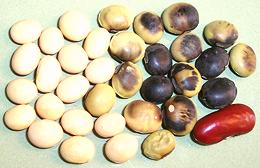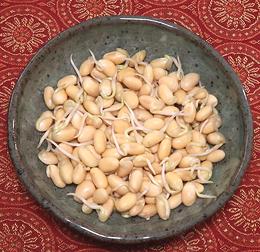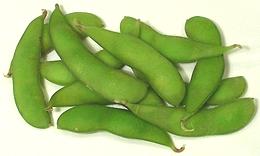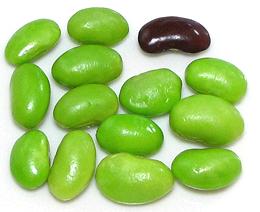 [Bhatt (India); Glycine max]
[Bhatt (India); Glycine max]
Soybeans are probably native to China and have been important to agriculture there since the earliest times - but not as a food crop. The beans were planted as a fallow field rotation crop to fix nitrogen and restore fertility to the fields, then plowed under. The photo specimens include whole fresh pods, fresh beans (edamame), dried white beans, black beans, and our ever present red kidney bean for scale.
Much is made in health food circles of soy's (almost) "complete protein". This claim is true, but it would be a lot more useful if the soybean was actually edible rather than shot through with toxins, mineral blockers, vegetable hormone analogs and the like. The plants developed these specifically to fight animal predation - and we are animals.
In China, during the Chou Dynasty (1132-246 BCE), a method of fermenting soybeans to detox them was developed, resulting in the paste we now know as Miso, and similar products. A little later a method was developed to make a soybean cheese from finely ground soybeans by precipitating solids with a salt - the product we know as tofu. Most, (but not all) of the toxins are discarded with the liquid. Fresh soybeans see limited use as appetizers and soybean sprouts see fair use but not so much as mung bean sprouts.
Contrary to popular belief in the US, Asians eat soy products, including tofu and sprouts, only in moderation and not as a really significant part of their diets. Unprocessed soybeans have only been much eaten in times of famine.
The vast bulk of soybean production is used to produce oil which may be used as cooking oil or for other purposes. This oil is high in polyunsaturates (Omega-6) so exposure to heat should be strictly limited, and heavy use will seriously disrupt Omega-3 / Omega-6 balance. Once the oil has been chemically extracted, the solids left are used for animal feed, and as the basis for many modern soy products, some of controversial safety.
It has recently been reported that animals fed this mash from GMO soybeans are showing a significant increase in infertility and spontaneous abortions. More study is needed - study not financed by Monsanto or the soybean industry.
More on Beans, Peas, Lentils.
 Dried soybeans are easily available in Asian markets, particularly Korean
markets, but are not often cooked as such because of various toxins, mineral
blockers and other problems. They may be sprouted or processed in various
ways into other soy foods (see below). For sprouting, or making Tofu, be
certain your Soybeans are very fresh, some are sold specifically for
sprouting.
Dried soybeans are easily available in Asian markets, particularly Korean
markets, but are not often cooked as such because of various toxins, mineral
blockers and other problems. They may be sprouted or processed in various
ways into other soy foods (see below). For sprouting, or making Tofu, be
certain your Soybeans are very fresh, some are sold specifically for
sprouting.
 These sprouts are considerably larger than the familiar mung bean
sprouts, firmer, have more flavor, and can stand longer cooking. They
are easily available in most Asian markets, particularly Korean markets.
Koreans use them far more than anyone else, for a popular side dish, in
soups, as salads, and with rice - but always cooked. I have not seen any
claims that they contain significant amounts of the endocrine disrupters
of mature beans, but they do have a higher concentration of phytic acid
than unsprouted beans. This is a substance which reduces mineral absorbtion,
but only briefly - and also has positive attributes. Again - moderation.
These sprouts are considerably larger than the familiar mung bean
sprouts, firmer, have more flavor, and can stand longer cooking. They
are easily available in most Asian markets, particularly Korean markets.
Koreans use them far more than anyone else, for a popular side dish, in
soups, as salads, and with rice - but always cooked. I have not seen any
claims that they contain significant amounts of the endocrine disrupters
of mature beans, but they do have a higher concentration of phytic acid
than unsprouted beans. This is a substance which reduces mineral absorbtion,
but only briefly - and also has positive attributes. Again - moderation.
Soybean sprouts should be crisp with bright yellow tops and white stems with no evidence of wilting or discoloration. They must be cleanly produced and fresh. The main health risk from Sprouts is not anti-nutrients, but e coli and salmonella bacteria due to improper production and storage, but since these sprouts are always used cooked, that's less of a problem than with other sprouts. Refrigerate them in their plastic bag and they'll keep for several days - rinse well just before using.
Koreans insist any seed skins be removed. Traditionally, it was considered
sloppy not to pinch off the thread-like root tail before use in a recipe.
This is practice is fading for several reasons. It has been found that
important nutrients are in the root, nutrients that help develop childrens
brains and help recover from hangovers. Also pinching them off is very
tedious. This is a job traditionally assigned to obedient children eager
to help. This is a resource very scarce in North America, and becoming
increasingly scarce in Korea as well. Korean markets do sometimes stock
bags of sprouts with the tails already cut off at the factory.
 In India, sprouted seeds and legumes are very popular, but they are not
sprouted in the East Asian form. The photo to the left shows the common
Indian sprouted condition, not only for soy beans but for other beans peas
and lentils as well. These are recipe ready. In India, sprouts are always
cooked as an ingredient in recipes. Most of the nutritional changes from
dried beans to sprouts have already happened by this point. Beans for
sprouting should be very fresh. Some are sold specifically for sprouting.
In India, sprouted seeds and legumes are very popular, but they are not
sprouted in the East Asian form. The photo to the left shows the common
Indian sprouted condition, not only for soy beans but for other beans peas
and lentils as well. These are recipe ready. In India, sprouts are always
cooked as an ingredient in recipes. Most of the nutritional changes from
dried beans to sprouts have already happened by this point. Beans for
sprouting should be very fresh. Some are sold specifically for sprouting.
Soybeans in this condition easily stand up to cooking for 20 minutes and
longer. The 8+ hour soak, sprouting and significant cooking time reduce
soy toxins and anti-nutrients considerably. While sprouting the long slender
form used in East Asia takes special techiniques and equipment, the Indian
form is dead easy to do at home. The photo specimens were soaked 8 hours,
then sprouted, for a total time from dried beans of 33 hours.
 These are soybean pods, not quite mature, often steamed or lightly boiled
and served as appetizers in sushi bars. They are served as whole beans
but you eat them by biting the pod so the beans eject into your mouth.
They have been promoted in North America as a healthy snack and are
probably now eaten here much more than in Japan.
These are soybean pods, not quite mature, often steamed or lightly boiled
and served as appetizers in sushi bars. They are served as whole beans
but you eat them by biting the pod so the beans eject into your mouth.
They have been promoted in North America as a healthy snack and are
probably now eaten here much more than in Japan.
Unfortunately, they are reported to contain the same endocrine
disrupters and anti-nutrients as more mature beans, but in somewhat
lower concentration. These substances easily survive the light cooking
these beans are usually subjected to. On the other hand, eaten just
occasionally and in moderation they are not dangerous - but some people
are overusing them as a "healthy" snack food. Also 90% of soybeans grown
in North America are GMO and sprayed with Glyphosphate. The GMO form
and the Glyphosphate are the real dangers with soy. You can find
Edamame in plastic bags in the frozen foods section of most
supermarkets, and Yuppie targeting markets have piles of them.
 Fresh Soy Shell Beans are used in some Chinese recipes. Keep in mind
that unfermented soy has never been much eaten in Asia due to endocrine
disrupters and anti-nutrients, but as an occasional ingredient they
should not be a health problem. They are not as widely available as the
Edamame in the pod due to not having the Yuppie connection of in-the-pod,
but you can find them in plastic bags in the frozen foods section of
Asian markets. The photo specimens averaged 0.65 inch long, 0.34 inch
wide and 44 to the ounce. They were purchased from a large Asian market
in Los Angeles (Alhambra), product of China.
Fresh Soy Shell Beans are used in some Chinese recipes. Keep in mind
that unfermented soy has never been much eaten in Asia due to endocrine
disrupters and anti-nutrients, but as an occasional ingredient they
should not be a health problem. They are not as widely available as the
Edamame in the pod due to not having the Yuppie connection of in-the-pod,
but you can find them in plastic bags in the frozen foods section of
Asian markets. The photo specimens averaged 0.65 inch long, 0.34 inch
wide and 44 to the ounce. They were purchased from a large Asian market
in Los Angeles (Alhambra), product of China.
Soybeans are the basis for a great many products, both traditional and modern. Some are generally considered safe and others are suspect of being less than ideal.
bp_soyz 080923 - www.clovegarden.com